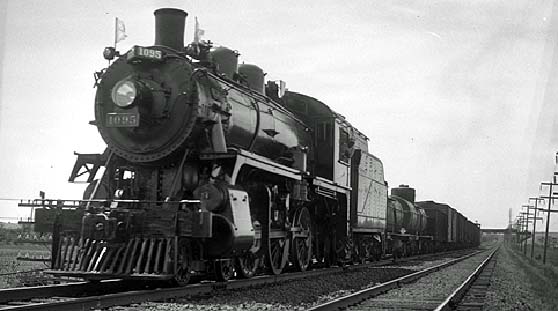

Kingston's iconic Engine 1095 was in active service until 1960 - Date unknown Ontario
Science Centre. |
23 May 2011
Engine 1095 The Spirit of Sir John A.
Kingston Ontario - Engine 1095, known as "The Spirit of Sir John A." has been a favourite photo back-drop for tourists
visiting Confederation Park for more than 40 years.
It is a reminder that the Tourist Offices' was the K&P Railway station for more than 75 years, and that Kingston was home for 114 years to the Canadian
Locomotive Company. That company built more than 3,000 steam, electric, and diesel engines. The Spirit of Sir John A. was one of 25 such models built for the
Canadian Pacific.
The locomotive was in active service until 1960. In 1966 it was saved by the Kingston Jaycees and given to the City in recognition and celebration of Canada's
Centennial in 1967. Though not a railroad custom, the 1095 was renamed The Spirit of Sir John A. and Bob Fray who was Mayor of Kingston at that time, and a
sign-writer by trade, painted the name on the side of the coal tender in gold heraldic script.
Restoration Work with Local Partners
On 15 Mar 2011, work began to remove designated substances, including asbestos and lead paint, from the historic locomotive in order to ensure it can be safely
moved and restored. After the removal of the designated substances is complete, work will start on the construction of a new foundation a few metres southwest
of where the locomotive now sits followed by the restoration itself. The City will be working with Local 221, the Pipe Fitters Union, and a number of other
local trade unions and industry partners on the restoration and relocation project, which is expected to be completed in 2012.
Restoration Project Background
In 2007, an initial Survey of Findings and Recommendations was submitted to Council by a volunteer-led group known as the "Engine 1095 Restorers" who
made an expert case for its restoration along with a proposed course of action and budget for the necessary work. This initial request was followed by a
further Report to Council in May 2010 prepared by City staff requesting full budget and approvals for restoration and relocation of the 1095.
Based on a thorough assessment of the locomotive, it has been identified that it must be relocated and restored due to the deteriorating conditions of both the
supporting track structure and the locomotive itself.
The City of Kingston will be working with Local 221, the Pipe Fitters Union and a number of other local trade unions and industry partners to restore The
Spirit of Sir John A. so that it can continue to be one of Kingston's most popular and photographed landmarks. The $812,000 project is expected to be completed
by the end of 2011.
The Historical Significance of Engine 1095
The presence of Engine 1095 in Kingston provides a crucial link to the City's industrial past having been built by the Canadian Locomotive Company Ltd. (CLC),
formerly located on the Kingston waterfront. For over a century the CLC was a major supplier of locomotives to the CPR, delivering nearly one-third of its
fleet over a number of decades and making it Canada's second largest commercial builder at the time.
Engine 1095 first made its debut in 1913 and was put into service out of Winnipeg and then Southern Ontario before completing its service life in Montreal in
1960. As a symbol of 19th century technology and industry, the continuing existence of Engine 1095 points to a significant period in Kingston and Canada's
history that demands to be preserved and maintained. It also helps to illustrate a significant aspect of Kingston's history by positioning it as an important
industrial and political hub.
About the Ten Wheeler Class Locomotive
The 1095 was one of the last batch of 25 units of 4-6-0 Ten Wheeler Class D10h, built by the Canadian Locomotive Company Ltd. in October 1913, builder's serial
number 1131. There were some 500 built by CPR at its own Angus Shops in Montreal, Quebec, and by other locomotive builders such as the Montreal Locomotive
Company Ltd. over the previous decade.
Between 1905 and 1913 the D10 became the single largest class of engine to be used by Canadian Pacific. An extremely versatile design, these locomotives were
used in passenger, freight, and yard service across Canada right up until the end of the steam era in the early 1960s.
These engines were a transitional design that reflected changes in locomotive engineering while also retaining some features typical of nineteenth-century
engines. For example, the engine cabs were of a simple open design. This provided some respite from the high heat generated by the firebox, but in inclement
weather, the open design meant that the locomotive crew was protected only by a simple canvas curtain drawn across the back of the cab-even in winter. The
engines also continued to be hand fired, except for a few that were converted to oil fuel.

|

